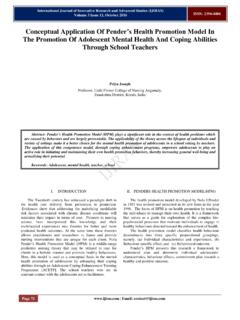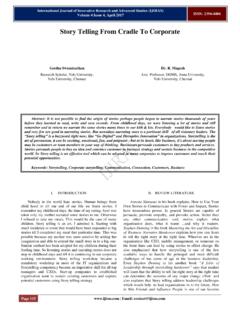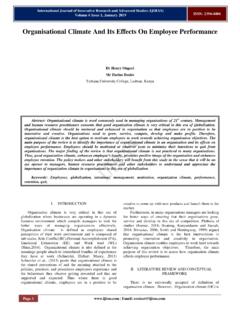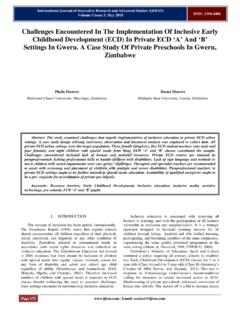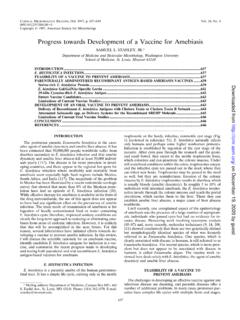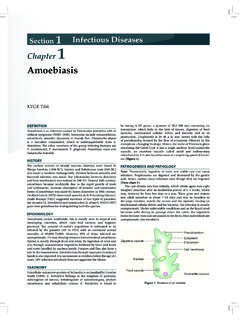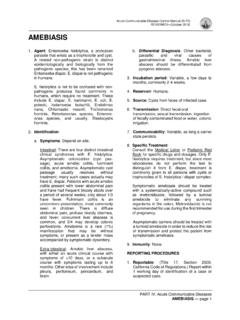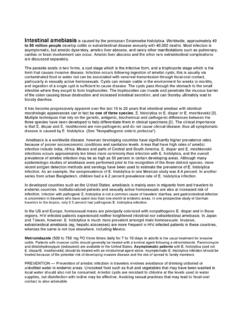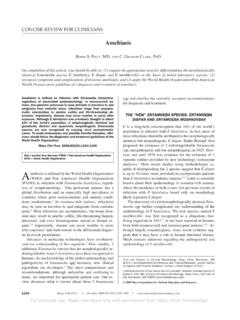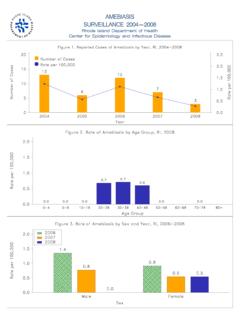Transcription of Amebiasis - E.Histolytica A Catalyst Of The Beginning Of ...
1 Page 295 | Email: International Journal of Innovative Research and Advanced Studies (IJIRAS) Volume 4 Issue 3, March 2017 ISSN: 2394-4404 Amebiasis - A Catalyst Of The Beginning Of Tumor And Other Complications Dr. Svistunov O. P. , Consultant of Medical Department ALSCON (Rusal) in Nigeria, Specialist in Tropical Medicine and Hygiene (University ), Physician Infectionist ( ), Member of the Royal Society Specialists in Tropical Medicine (England) Dr. Anya Kalu Dr. Ime Umoh Laboratory Assistant, Parasitologist, Isuwu Ifeanyi, Hospital ALSCON in Nigeria I. INTRODUCTION The protozoal infection remains a major cause of high morbidity of the population. It is well described by experts of different countries of the world and there are a great number of drugs for the treatment of this disease. (3) We studied two protozoal diseases - malaria and Amebiasis . Malaria is usually an acute infectious, well described process with not always clinically flowing picture.
2 The methods of its diagnostics and treatment are well established. That is why we did the emphasis on the study of the epidemiology, clinic, diagnostics, treatment and prevention of Amebiasis . The main cause of this disease is the penetration of cysts into the body. The aims of our research are to develop a simplified method of diagnostics of Amebiasis , to work out the simplest methods of treatment until the full recovery of the patient and, certainly, the prevention of Amebiasis . Moreover, the long-term consequences of the damage of the human body by cysts and by mobile trophozoites - erythrophage have not been studied yet. It is still believed that there is asymptomatic carrier morbidity of but our team of specialists does not support this opinion. Abstract: In 2007 we drew attention to the fact that an increasing number of patients were seeking care in the hospital Alscon plant in Nigeria with the symptoms of damage of different organs and tissues and the clinical manifestations caused by the lesion of one particular organ.
3 The target organs of the lesion were uterus, liver, intestines, eyes, prostate, brain, heart, breast, and other organs. For the first time in the period from 2007 to 2009 we conducted a study of more than 1,250 patients in the region Akwa Ibom, Ikot Abasi and have found out that the main reason of the defeat was (1, 2). In the period from 2009 to 2014 we continued to study Amebiasis and have come to a series of conclusions. Amebiasis can not be asymptomatic without clinical manifestations. Trofoz oit-erythrophage causes serious complications. It forms chronic, weakly flowing course of disease, leading to the depletion of the body which is the cause of the wide range of secondary diseases and represents a high risk to the health of patients. We examined the patients from different regions of the world: Nigeria, Cape Verde, Israel, South Africa, Senegal, Mozambique, Namibia, Russia, Ukraine, Portugal, the United States and other countries. We are convinced that doctors in different countries and regions do not understand or do not represent that along with dangerous infections as AIDS, malaria and schistosomiasis, Amebiasis is the most hidden and poorly understood infectious disease which affects rapidly a large number of people without a certain incubation period.
4 It causes a lot of complications which may occur in any period of patient s life. Page 296 | Email: International Journal of Innovative Research and Advanced Studies (IJIRAS) Volume 4 Issue 3, March 2017 ISSN: 2394-4404 II. EPIDEMIOLOGY OF Amebiasis Epidemiology of infection by cysts, as a cause of the defeat of the human body was described by many authors. (10,11,12,13,14) The prolong existence of cysts in natural foci contributes to the rapid spread of amoebiasis around the world. In most African countries water is the main source of infection. In countries with hot humid climate such as Nigeria, Cameroon, Mozambique, Amebiasis is widespread throughout the country. In hot and dry countries with open sources of water used by the local population, the largest number of patients with Amebiasis is observed. (Libya, Cape Verde, South Africa). Eating of vegetables, fruits without heat treatment promotes the penetration of cysts into the intestine and the development of the disease.
5 The serving staff of restaurants, shops, local market traders in most cases is the source of Amebiasis infection. Patients with chronic form of Amebiasis complicated by the lesions of uterus, prostate, lung, amebomas of intestine are a constant source of Amebiasis infection. (15). III. MATERIALS AND METHODS Since March 2007 the investigation of the main causes of morbidity of the factory workers and the local population in the area of the plant, a state of Akwa Ibom, has been started in the Nigeria hospital of Aluminium Plant Alscon. We also conducted the constant surveillance of foreign experts. The patients from different regions of Nigeria and from other parts of Africa such as Cape Verde, Senegal, South Africa, Mozambique, Libya, Zimbabwe, Angola, Cameroon and the patients from the ECOWAS countries were examined. Besides we conducted laboratory screening of residents of Tver (Russia) in a laboratory of the city Hospital N1.
6 We examined patients of all ages, from 1 to 90 years. Patients from schools, kindergartens, shops, markets and patients of gynecological and surgical clinics, restaurant staff were included into our study. During the period from 2007 to the present time we examined 6520 patients from Central Africa, South of Africa (3020 males, 3500 females) and 450 persons from Russia (Tver, Russia). Most of them (5410 pers.) were examined for cyst carrier morbidity, although some of them had uncertain clinical manifestations of the disease. IV. LABORATORY DIAGNOSTICS The simplest form of diagnostics of Amebiasis is microscopic analysis of feces. (5, 6, 7). In a container with two standard container spoons of stool we add 5 ml. of saline. After shaking one drop of medication is applied to a glass slide and is covered with a cover slip. The presence of mobile trophozoites is estimated and the number of cysts is counted. We investigated the presence of mobile trophozoites in fresh stool samples and after passing some hours or days.
7 When the container is stored at room temperature, moving trophozoites can be found in stool for 3 days, in two weeks cysts are reduced in size and then disappear. The conclusion on the extent of the body damage is made according to the presence of living trophozoites and the amount of cysts in the 10 fields of view. The presence of 1 to 10 cysts is denoted by one plus (+), the presence of 10 to 30 cysts - by two pluses (++) and 30 or more cysts - by three pluses (+++). But this is not a criterion for assessing of the severity of the disease. Only on the basis of clinical and other research methods one can judge about the state of health of the patient affected with (8) If cysts in stool are detected in males of the genital age it is recommended to examine the urine and sperm on the presence of cysts. It is also recommended to study the samples microscopically after the prostate massage, no less than in the 10 fields of view, without the saline dilution.
8 The count of cysts is carried out in the same manner as in case of stool analyses. Females, especially with gynecological problems, are required thrice microscopy of the smears from the walls of the vagina and cervix for the presence of cysts and mobile trophozoites of V. ADDITIONAL METHODS OF RESEARCH The complete blood analysis was carried out in all patients if was observed in their stool. In patients with a clinical picture of anemia, multiple uterine fibroma and hemorrhoidal hemorrhages the values of red blood (hemoglobin, erythrocytes) were significantly reduced. The gastroscopic and colonoscopic investigations were conducted if they were indicated. In most cases, the mucous of rectum and sigmoid were injured by multiple, deep and bleeding ulcers with purulent contents. On colonoscopy in the dome of the cecum one can see the submucosal, yellowish, multiple, grainy formations in size from cm to 3 cm. resembling caviar.
9 In different parts of the colon one can detect single amebic polyps. In case of the prolonged and incorrect treatment of Amebiasis the commissure are formed and the obstruction of the affected area may occur in future. Histological examination and removal of polyps are recommended. (16) On histological examination it is necessary to differentiate malignant adenocarcinoma from adenocarcinoma with chronic current Amebiasis caused by It is necessary to investigate the biopsy specimens for the presence of cysts and trophozoites of E. histolytica. At present the importance of social screening colonoscopy and polypectomy is recognized, because colorectal cancer ranks the third place in cancer morbidity and mortality in the world. The patients with intraepithelial neoplasia and highly differentiate intramucous carcinoma have favorable prognosis in case of removal of the polyp in time and subsequently annual monitoring of the large intestine.
10 ( Nikishaev, , ). At present we believe that the damage of the colon by cysts and trophozoites is one of the main triggers of amebomes, precancerous adenocarcinomas of the intestine and other organs infected by live trophozoites-erythrophage such as uterus, prostate, organs of sight, mammary glands, all organs with the smooth muscular fibers. Ultrasonic investigation and echocardiography are indicated to all patients with Amebiasis . Ultrasonic examination of the uterus and the prostate should be Page 297 | Email: International Journal of Innovative Research and Advanced Studies (IJIRAS) Volume 4 Issue 3, March 2017 ISSN: 2394-4404 conducted for all patients of the childbearing age. Mammography is recommended for women to detect amebome of the mammary glands. VI. PATHOLOGY-ANATOMY STUDY OF AMEBOME OF UTERUS The post-mortem study of remote amebome of the uterus was conducted in 31 patients.

